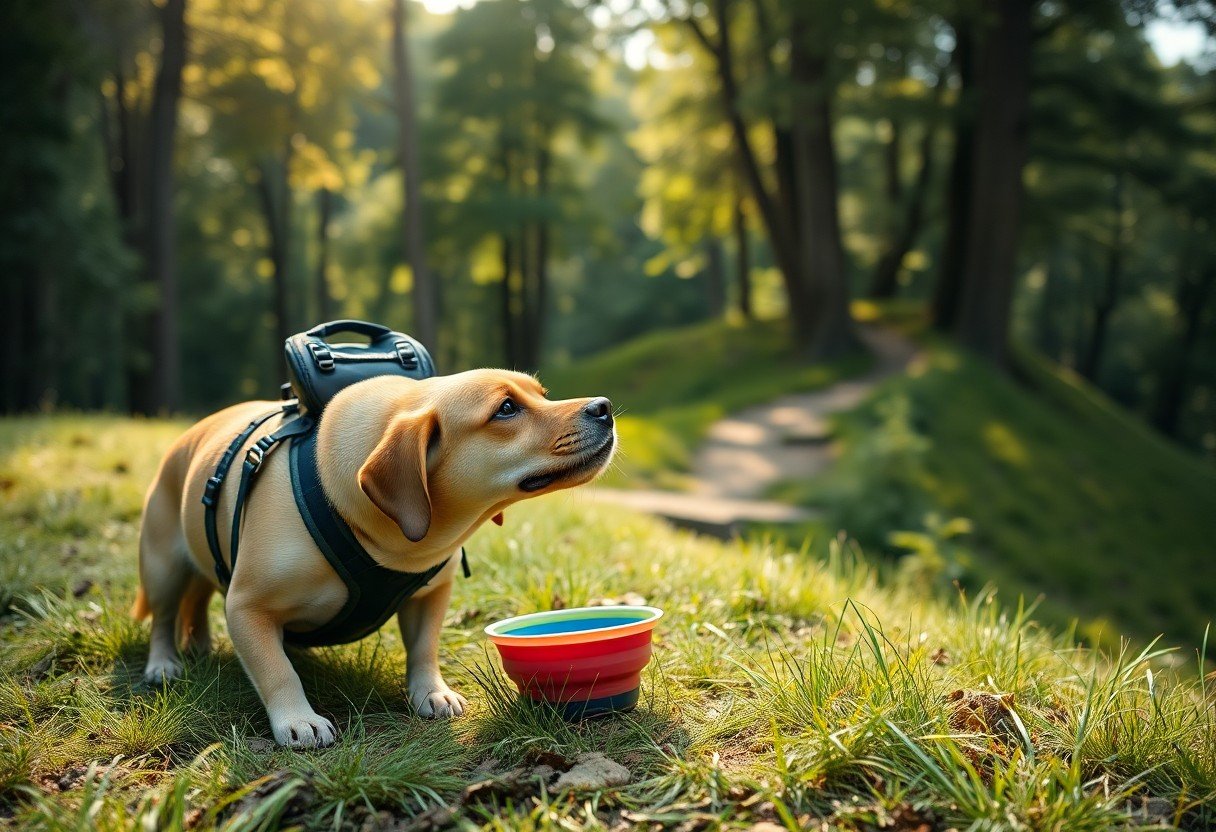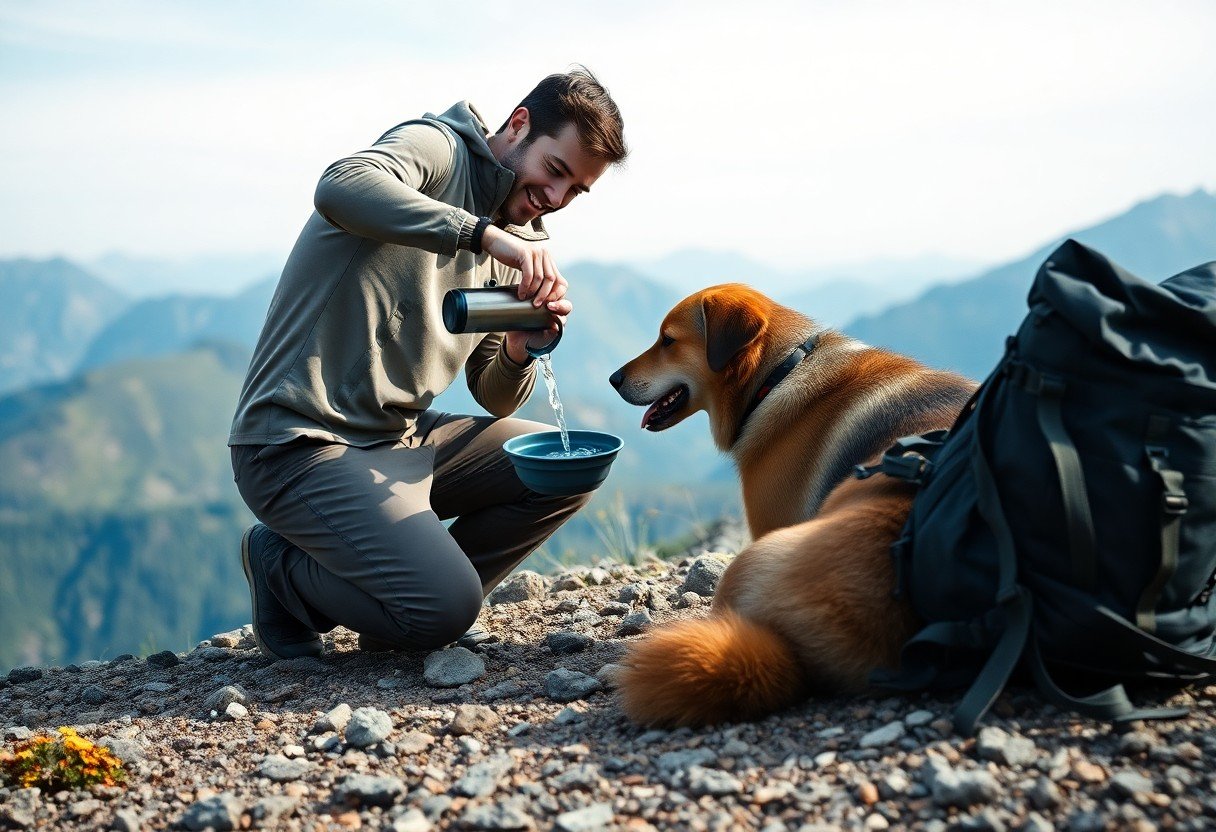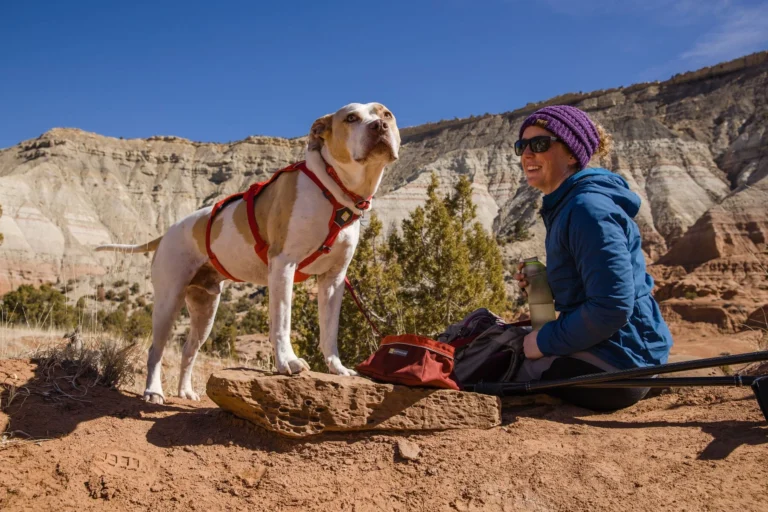Hydration is crucial for your dog’s health, especially during long walks and hikes. Without adequate water intake, your pet can quickly become dehydrated, leading to serious health issues. To ensure your dog stays well-hydrated, always carry enough water and seek out shady spots for breaks, particularly on hot days. Offering water every 30 minutes can help maintain their energy and mood. Additionally, consider using a portable dog bowl or hydration pack to make it easier for you to provide consistent access to water throughout your adventure.

Key Takeaways:
- Bring a portable water bowl to easily hydrate your dog during breaks.
- Offer water every 15-30 minutes, especially in warm weather.
- Monitor your dog’s behavior for signs of dehydration, such as excessive panting or lethargy.
Importance of Hydration for Dogs
Hydration plays a vital role in your dog’s overall health and well-being. Water supports digestion, nutrient absorption, and temperature regulation. During physical activity, especially on long walks or hikes, dogs lose fluids through panting and sweating. Ensuring your furry friend stays hydrated not only prevents fatigue but also protects against heat-related illnesses. Adequate hydration fosters energy levels, helps maintain stamina, and can even improve your dog’s mood on excursions.
Effects of Dehydration
Dehydration negatively impacts your dog’s physical performance and can lead to serious health issues. When fluid levels drop, your dog may experience decreased energy, muscle cramps, and impaired cognitive function. In severe cases, dehydration can cause organ failure or heat stroke, which can be life-threatening. Rapid dehydration can occur in hot environments, making vigilance crucial during outdoor activities.
Signs of Dehydration in Dogs
Identifying signs of dehydration in your dog can prevent serious health complications. Common indicators include dry gums, lethargy, reduced skin elasticity, and excessive panting. If your dog’s urine is unusually dark, it can signal a lack of fluids. Observing these symptoms during your hikes allows you to take immediate action to rehydrate and ensure your dog’s safety.
Monitoring your dog’s hydration status requires close attention to their behavior and physical condition. Check their gums; they should appear moist and pink, rather than dry and pale. Pinch the skin on the back of their neck—if it doesn’t spring back quickly, that can indicate dehydration. Keep an eye on your dog’s energy level; if they seem unusually tired or unwilling to continue, a water break is necessary. Prompt recognition of these signs allows you to address hydration issues before they escalate into serious problems.
Preparing for Long Walks and Hikes
Proper preparation ensures both you and your dog enjoy long walks and hikes. Plan your route ahead of time, factoring in trail conditions and available water sources. Carry enough water for both of you, and consider breaks for rest. Familiarize yourself with 4 ways you and your dog can stay hydrated on hikes to ensure an enjoyable outing.
Assessing Your Dog’s Hydration Needs
Understanding your dog’s specific hydration needs involves evaluating their size, age, and activity level. Larger dogs may require more water, while working or active breeds can sweat more and need consistent hydration. Monitor your dog’s behavior for signs of dehydration, such as excessive panting or dry gums, and adjust water intake accordingly.
Choosing the Right Gear
Selecting the right gear significantly impacts your dog’s hydration on hikes. Invest in a portable dog water bottle or collapsible bowl for easy access. Look for backpacks designed specifically for dogs that can carry their water and additional supplies. Lightweight, insulated water flasks keep hydration supplies cool and accessible.
Consider the size and weight of the gear to ensure your dog can carry it comfortably. Look for products that are durable and easy to clean. Also, pack additional items like dog-specific hydration packets or electrolytes, which can help replenish necessary minerals if you plan a strenuous hike. A well-equipped outing enhances your dog’s experience, ensuring they stay healthy and energized.
Water Sources on the Trail
Finding reliable water sources on your hiking route can significantly ease your dog’s hydration needs. Streams, rivers, and lakes alongside trails often provide spots where you can refill your water supply. Always be mindful of the water quality, as stagnant water can harbor harmful bacteria. Carry a filtration system or purification tablets if you plan to use natural sources, ensuring your dog stays safe while quenching its thirst.
Identifying Natural Water Sources
Look for signs of flowing water, such as vegetation or animal tracks leading to rivers and streams. If the trail approaches a natural water body, check its clarity and movement; flowing water is typically safer than stagnant pools. Always assess the area for potential contaminants, especially in crowded parks.
Carrying Your Own Water
Bringing your own water is one of the simplest ways to ensure your dog stays hydrated. Invest in a lightweight, collapsible water bowl that fits easily in your backpack. Fill a sturdy water bottle or hydration pack with enough water to last for both you and your dog during your hike. A good rule of thumb is to provide about 1 ounce per pound of body weight for your dog daily, adjusting for exercise levels and temperatures.

Hydration Techniques
Effective hydration techniques enhance your dog’s comfort and performance on long walks and hikes. Implementing strategies such as offering water regularly and utilizing specialized hydration packs or bowls can make a significant difference in their hydration levels.
Offering Water Regularly
Offer your dog water every 30 minutes during your outdoor adventures to ensure they stay hydrated. Even if they don’t seem thirsty, regular offerings help to prevent dehydration and keep their energy levels up. Bring a collapsible bowl or a portable water bottle for easy access.
Using Hydration Packs or Bowls
Hydration packs or specially designed portable bowls can simplify the process of keeping your dog hydrated while on the go. Look for products that are lightweight and easy to carry, ensuring you can offer water without a hassle.
Hydration packs come with built-in water reservoirs and dispensers, allowing you to quickly fill your dog’s bowl without needing additional gear. Many designs also feature straps for hands-free carrying, making them ideal for longer treks. Portable bowls are typically made from collapsible materials, fitting conveniently in your gear while providing a stable drinking surface wherever you stop. These tools enable you to maintain hydration for your dog efficiently, ensuring they can enjoy your outdoor adventures without the risk of becoming dehydrated.
Special Considerations for Hot Weather
Hot weather requires extra attention to ensure your dog remains hydrated and comfortable during walks and hikes. The high temperatures can quickly lead to heat-related issues, affecting your dog’s energy levels and overall well-being. Taking breaks in shaded areas, adjusting walking times to cooler parts of the day, and monitoring your dog’s behavior are vital strategies to keep them safe in the heat.
Recognizing Heat Stress
Heat stress manifests through signs such as excessive panting, drooling, lethargy, and difficulty breathing. Watch for unusual behavior, such as your dog seeking shade or lying down more frequently. If your dog shows signs of distress, prompt action is necessary to prevent serious health risks, including heatstroke, which can be life-threatening.
Tips for Keeping Your Dog Cool
To help your dog beat the heat, offer plenty of fresh water during breaks and consider carrying a portable water bowl. Choose lightweight gear that reflects heat and provides ventilation. A cooling vest or bandana can also effectively regulate their temperature. Ensure frequent breaks in shaded or cool areas to encourage proper hydration and rest. Perceiving your dog’s needs can help maintain their comfort and safety.
- Fresh water during breaks
- Lightweight gear for shade
- Cooling vest to regulate temperature
- Frequent breaks in shaded areas
- Perceiving your dog’s individual needs is crucial for health.
Implementing a few simple methods can greatly enhance your dog’s comfort in hot weather. Carry a misting spray bottle to create a cooling effect, and plan your route to include areas with natural shade like trees or buildings. You might also consider freezing treats or ice in a water bowl to create a refreshing treat, offering hydration in a fun way. Perceiving small adjustments can make a significant difference in your dog’s overall hiking experience.
- Misting spray bottle for cooling
- Natural shade for breaks
- Frozen treats for hydration
- Perceiving the immediate environment can enhance your dog’s comfort.
Summing up
Following this guide will help you keep your dog hydrated on long walks and hikes. Always carry enough fresh water in a portable container and offer it to your dog regularly, especially during breaks. Use collapsible bowls for easy access and be mindful of your dog’s hydration needs based on weather conditions and activity level. Watch for signs of dehydration and adjust your travel plans accordingly. With these strategies, you can ensure that your dog stays healthy and energized while enjoying your outdoor adventures together.
FAQ
Q: How often should I give my dog water on long walks or hikes?
A: It’s best to offer your dog water every 30 minutes during walks or hikes. This helps them stay hydrated, especially in warm weather or if they are exerting themselves more than usual.
Q: What is the best way to carry water for my dog while hiking?
A: Use a collapsible water bowl or a portable dog water bottle designed for hiking. These options make it easy to provide your dog with water when needed without taking up much space in your pack.
Q: Are there signs that my dog may be dehydrated during our outdoor activities?
A: Yes, look for signs such as excessive panting, lethargy, dry gums, and decreased skin elasticity. If you notice any of these symptoms, it’s important to take a break and offer water immediately.







